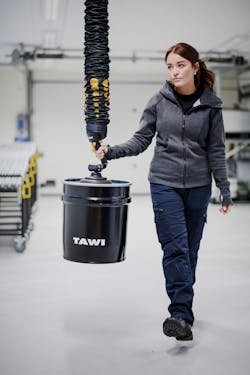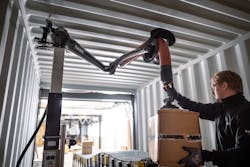Using lifting equipment in bulk material handling
Efficient bulk material handling serves as the backbone of various industrial sectors, including chemicals, pharmaceuticals, and food processing. These industries heavily rely on the effective handling and transportation of bulk materials — both raw materials and finished goods — for internal operations and for supplying products to the market.
Moreover, these industries often operate in clean room environments where there is zero tolerance for contamination. Cleanliness here transcends the mere absence of visible dirt; it extends to microscopic pollutants that can compromise product integrity or pose a health risk to workers. Maintaining these standards is both challenging and essential.
Clean room lifting equipment
Clean room lifting equipment is designed specifically for industries that demand a high degree of cleanliness and hygiene. Clean room lifting equipment features hygienic, stainless-steel design that ensures compatibility with clean room environments and minimizes the risk of contamination.
Moreover, clean room lifting equipment is optimized to address safety, hygiene, current Good Manufacturing Practices (cGMPs) and ergonomic efficiency. These factors are crucial in industries where worker safety and productivity are paramount.
Best practices for using lifting equipment in bulk material handling
With the right equipment and strategies, companies can not only comply with stringent industry regulations, but also improve their operational efficiency, worker safety and overall productivity.
Enhancing efficiency
To enhance efficiency in bulk material handling, operators should receive proper training on equipment operation and controls. Proficiency in handling bulk materials efficiently is essential to meet production demands and maintain competitiveness.
In the food and beverage industry, vacuum technology has emerged as a safe and efficient solution for lifting, moving, and sorting products. By implementing vacuum lifting solutions, companies can revolutionize their material handling processes.
Vacuum lifters utilize suction cups to securely grip and lift items, eliminating the need for manual handling and reducing the risk of injuries. This increases productivity by enabling faster and more efficient handling of bulk materials.
Moreover, by reducing the reliance on manual handling, vacuum lifting solutions contribute to the overall health and safety of workers, particularly in the food and beverage industry. Manual lifting activities in this industry often involve heavy loads and repetitive motions, which significantly increase the risk of musculoskeletal injuries.
By minimizing the need for manual lifting, vacuum technology helps prevent work-related injuries and promotes a safer working environment.
Ensuring worker safety
Worker safety is a paramount concern in industries such as chemicals, pharmaceuticals and food, where manual handling tasks are prevalent. Proper training on correct lifting techniques and equipment usage is vital to prevent work-related musculoskeletal disorders (MSDs) and work-related upper limb disorders (WRULDs) that commonly result from these tasks.1
Implementing appropriate lifting equipment solutions and providing comprehensive training not only protects employees from potential injuries but also has a significant economic impact. Also, lifters that have safety features such as emergency stop buttons, overload protection and audible alarms ensure the safety of operators during operation.
An unsafe workplace can lead to equipment damage, production losses, absenteeism and damage to the company's reputation, all of which incur substantial costs. By prioritizing worker safety and investing in ergonomic lifting solutions, companies can mitigate these costs and promote a safe and productive work environment.
Increasing precision in material handling
Understanding the weight capacities and capabilities of lifting equipment is critical. Accurate knowledge of these factors ensures that operators can exert precise control over the handling of bulk materials, substantially minimizing the risk of damage to products or accidents involving personnel. Incorrect or imprecise handling can not only lead to product loss but also pose significant safety hazards, making this understanding a crucial aspect of operations.
Vacuum lifting systems have risen to prominence due to the high accuracy and flexibility they offer. They provide a controlled environment for handling various packaging materials — including drums, sacks, and bags — with exceptional precision and safety. Given the high stakes involved, especially in industries such as pharmaceuticals that deal with sensitive products, these systems provide an added layer of security and assurance.
Streamlining workflow and throughput
Careful coordination of tasks, strategic positioning of equipment, and logical sequencing of operations can greatly enhance workflow and improve throughput. For instance, planning for efficient warehouse loading and unloading procedures can eliminate unnecessary movements, saving time and reducing the risk of accidents.2
Implementing the right tools can greatly enhance these efforts. Vacuum lifters, clean room products, and ATEX-certified solutions offer a range of benefits. They can enable safe and efficient packing, palletizing, and receival of incoming products, critical tasks in industries such as chemicals and food processing.
These solutions not only augment workflow speed and efficiency, but also contribute to safer work environments. In addition to making operations more efficient, they can help businesses meet regulatory standards, contributing to long-term success.
Preventing spills and accidents
In industries where bulk materials are handled regularly, preventing spills and accidents is a primary concern. Safe material handling goes beyond simply using the right tools; it encompasses numerous factors, including equipment selection and maintenance.
Selecting the correct gripping or suction cups for handling materials is crucial. The right attachment not only ensures a secure grip but also enables smoother and more controlled operation. This, in turn, helps prevent accidental spills or drops that could lead to product loss, potential contamination or worker injury.
However, the right equipment is only as reliable as its maintenance schedule. Regular inspection and maintenance of lifting equipment play a vital role in preserving its functionality and longevity. This proactive approach can help detect and rectify potential issues before they escalate, contributing significantly to workplace safety and the bottom line.
Handling versatility
Different industries deal with various types of bulk materials, each with its own handling requirements. Understanding the range of bulk materials that lifting equipment can handle is paramount in sectors such as chemicals, pharmaceuticals and food processing.
Such understanding includes knowing how to handle various packaging forms such as boxes, cartons, bags, sacks, drums, kegs, barrels and crates. Familiarity with these forms can help operators optimize their handling techniques and the use of equipment, thereby improving efficiency.
Moreover, equipping lifting devices with suitable attachments and accessories allows for greater versatility. Whether it is a unique gripping tool for irregularly shaped packages or a different type of suction cup for heavier loads, adapting equipment to specific material handling needs can greatly enhance handling efficiency while reducing the risk of accidents.
Allowing customization and adaptability
Customizing lifting equipment to meet unique operational requirements can be highly beneficial. Customization goes beyond merely adjusting equipment specs — it should focus on enhancing safety, increasing efficiency, and complying with industry-specific regulations.
Adaptability, for instance, might involve the use of stainless-steel configurations in clean room environments. Stainless steel is both robust and hygienic, making it ideal for environments that require strict contamination control. Likewise, ATEX-certified solutions — equipment certified as safe for use in explosive atmospheres — can offer enhanced safety and efficiency for industries handling dangerous or volatile raw materials.
By focusing on such customizations and adaptations, industries can not only increase operator protection and production efficiency but also uphold rigorous hygiene standards. This, in turn, contributes to the long-term viability and success of the organization.
Moving forward: the key to success
Following best practices in using lifting equipment for bulk material handling is crucial. Clean room lifting equipment plays a pivotal role in improving processes, increasing worker safety, and meeting specific industry needs. Adopting ergonomic lifting solutions is not only a smart choice but a necessary one to optimize efficiency and minimize the risk of injuries in bulk material handling operations. By prioritizing training, safety, precision, efficiency and adaptability, industries can ensure smoother and safer bulk material handling, ultimately contributing to their overall success.
References
1. https://oshwiki.osha.europa.eu/en/themes/introduction-musculoskeletal-disorders
2. https://www.tawi.com/insights/efficient-loading-and-unloading/
Matilda Odell is marketing automation specialist at TAWI, a brand by Piab Group, which enables smart lifting optimized for people and businesses. Piab helps its customers grow by transforming their businesses with increased automation.
TAWI





